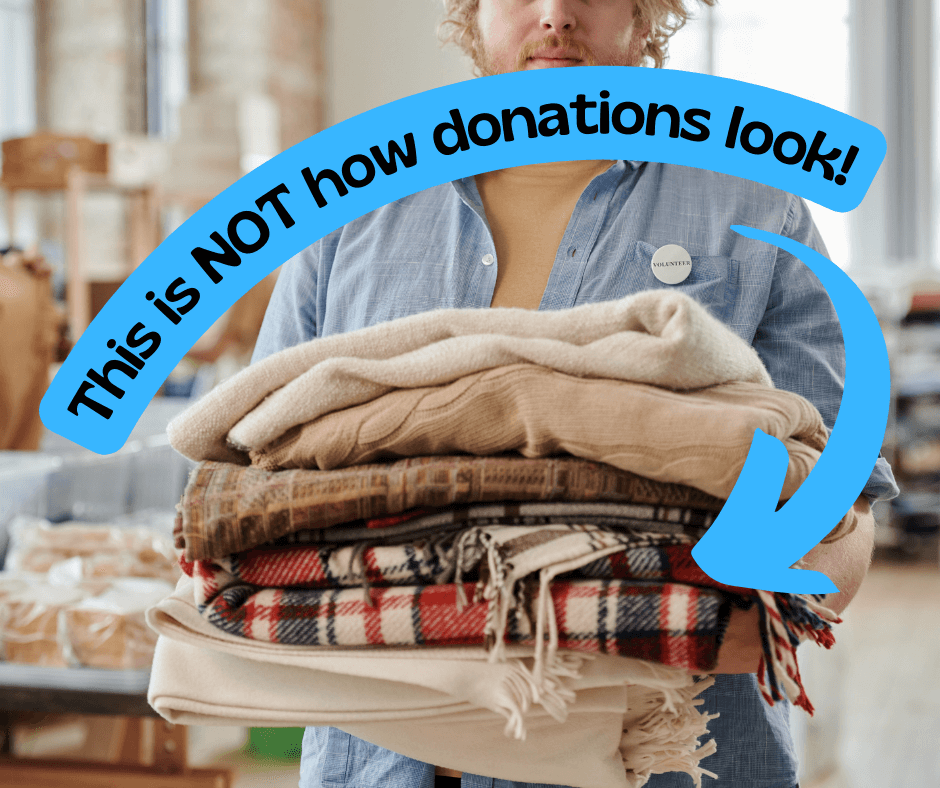Thrift stores only put out SOME of the donations
So, what really happens behind the thrift store curtain? What do they really do with donations? Why are they raising their prices? I worked in a thrift store for over eight years, and I can give you some of those answers.
Did you know that thrift stores only put out 10-15% of the donations they receive? That might sound low to you, but it’s accurate, and there’s a lot of reasons why.

Blame fast fashion
 The first reason is probably the most obvious, there’s something wrong with it. (Excuse me while I get on my soapbox.) Today, brands like H&M and Forever 21 can produce clothing so quickly and cheaply, that people don’t mind wearing them two or three times before getting rid of them and buying something new.
The first reason is probably the most obvious, there’s something wrong with it. (Excuse me while I get on my soapbox.) Today, brands like H&M and Forever 21 can produce clothing so quickly and cheaply, that people don’t mind wearing them two or three times before getting rid of them and buying something new.
There are also huge environmental and humanitarian impacts that you should learn about because they will affect us for generations. To learn more about them, please read What is Fast Fashion and How You Might Already Be Fighting It. (Ok, I’m mostly getting off my soapbox.)
My point is, clothing produced today doesn’t last as long as clothing produced in previous decades. It was never meant to. So, a lot of clothing being donated today has rips, tears, pills, seam pops, or other imperfections that make them not worth keeping.
If you’re one of those people who washes your clothing, and neatly folds it before donating it, there are two things you should know. One, I love you and I would take a bullet for you. Two, you’re rare. Most people who donate to a thrift store, are not motivated by the desire to help their local store, or the local charity they benefit. They are motivated by the single desire to clean out their house. The comparison might seem like hyperbole, but you don’t fold your banana peels when putting them in the trash, do you? Same principle. A lot of the donations that thrift stores receive are viewed as just that, trash. So, a lot of donations are what we call, “unsaleable.”
donations are what we call, “unsaleable.”
Some donations are unsaleable
“Unsaleable” sounds like a very clean word, so let me give you some examples of unsaleable goods. If you’re squeamish, you might want to skip this paragraph. I’m not talking about the usual stains and rips that, of course, can be found on a lot of thrift store donations. No, it gets worse. In the past, I have unpacked bags with soiled underwear, panties with bloody pads still adhered to them, bloody knives, bags with living animals and insects, broken glass, and boxes of electronics with handwritten notes like: “printer does not work”. Once, when we picked up from college dorm rooms after graduation, we found what appeared to be the remains of a chicken dinner. I don’t just mean the plates, knives and forks. I mean, there were plates, knives and forks, as well as days old mashed potatoes, a chicken carcass and what we believed were once steamed carrots.
It looked like the guys had started to fill a trash bag with their unwanted clothing and linens, then simply topped off the bag with their literal garbage. That kind of stratigraphy happens a lot more often than you think. People start out with good intentions, then fill up the trash bag with whatever is on hand. Those boxes and bags account for a lot of the kinds of donations thrift workers sort through every day.
Donating is an anonymous process
You might be telling yourself; I would never do something like that! You might be right, you wouldn’t. But would AnonymousWoman13?
Donating to a thrift store is a fairly anonymous process. Sure, a worker physically accepts the bag from you, but you don’t have to stand there as they open and sort it. Think of it as the difference between saying something into a mic at a town hall meeting, versus leaving a comment on YouTube. Anonymity hides a lot of sins.
How often have you been driving down the road and seen an entire couch sitting next to one of those yellow clothing donation bins? Or a super fat-backed TV? Or boxes of children’s stuff sitting out in the pouring rain? Those items were clearly not meant to be donated like that, but who cares? All they had to do was pull the car up and dump their stuff. Thrift stores spend a lot of time and money dealing with items like that. Unfortunately, those costs get pushed on to their customers.
Thrift stores have limitations
 You also have to remember that thrift stores can’t launder the pieces they receive. If you, as a reseller, find a piece with a small makeup or deodorant stain, one run through the wash has it looking good as new. Stores can’t do that. Any imperfection and it’s gone. That goes for storage space too. Simply speaking, there is none.
You also have to remember that thrift stores can’t launder the pieces they receive. If you, as a reseller, find a piece with a small makeup or deodorant stain, one run through the wash has it looking good as new. Stores can’t do that. Any imperfection and it’s gone. That goes for storage space too. Simply speaking, there is none.
Most of the thrift stores that I worked in had the capability to store 5-10 boxes of seasonal items. That’s it. If my store received a donation of perfect, pristine ugly Christmas sweaters in June, we ditched them. We just didn’t have the space to store them, so, if something was out of season, we couldn’t keep it. We also had to take into account whether or not we had room on our sales floor.
Thrift stores purge unsold stuff
Sometimes women’s pants are just not a big seller. When that happens, they get tossed. Every few weeks most thrift stores go through the aisles and purge anything that hasn’t sold in a long time. It’s not fun because even though you’re clearing up space, you’re also tossing out hours of work, and hours of salary paid to the people who did that work. It’s simply easier and more cost efficient to stop collecting that particular item. Some weeks, you are starving for jeans, the next week, you’re tossing them by the armful. Thrift is a weird world.
Finding something in perfect condition, in the right season, that hasn’t touched something icky and that you actually need can be a bit of a feat. But whether a thrift store worker finds one saleable item in an hour or one hundred and one, they get paid the same amount. The more a thrift store has to throw out, the less profit they make, and the more cost they have to pass on to their customers. In a way, I’m telling you that resellers are not responsible for rising prices. Big stores, and the customers who support them are.
There is also a weird, polar vortex-type situation right now with the pandemic and inflation. Because we have all, for the most part, been stuck at home for the last three years, we are ditching more stuff. At the same time, because a lot of us are working from home, gas prices are increasing, and inflation is rising, we aren’t buying as much stuff. That means that thrift stores are getting more donations, but actually selling less stuff. Just like the rest of us, stores are learning to be more selective. That, in large part, is why prices are rising.
Prices are increasing everywhere
The final reason prices at the thrift store are increasing, is that they are increasing everywhere. Every store, thrift or not, pays for their building, website, power, heat and air conditioning, employees, healthcare, etc. Everything costs more today than it did ten years ago. I felt like I officially became an old person last week, when I was standing in line at the grocery store, looking at the candy. I caught myself actually thinking, “When I was a kid, Snickers were bigger and they only cost a dollar.” Any day now my daughter will push me off into the ocean on an ice flow…
No one is immune from inflation
Seriously though, no one is immune from inflation and the ebb and flow of the economy. Please remember that the teenage girl working at the register doesn’t set corporate policy. Be as nice as you can, and try to diversify where you get your inventory. I’m such a cheapskate that I get 90% of mine for free! If you want to learn how, or learn more about thrift stores in general, check out my book The Clothing Reseller’s Handbook on Amazon!




